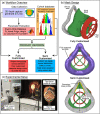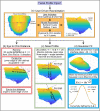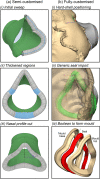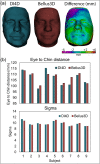A feasible route for the design and manufacture of customised respiratory protection through digital facial capture
- PMID: 34728650
- PMCID: PMC8563770
- DOI: 10.1038/s41598-021-00341-3
A feasible route for the design and manufacture of customised respiratory protection through digital facial capture
Abstract
The World Health Organisation has called for a 40% increase in personal protective equipment manufacturing worldwide, recognising that frontline workers need effective protection during the COVID-19 pandemic. Current devices suffer from high fit-failure rates leaving significant proportions of users exposed to risk of viral infection. Driven by non-contact, portable, and widely available 3D scanning technologies, a workflow is presented whereby a user's face is rapidly categorised using relevant facial parameters. Device design is then directed down either a semi-customised or fully-customised route. Semi-customised designs use the extracted eye-to-chin distance to categorise users in to pre-determined size brackets established via a cohort of 200 participants encompassing 87.5% of the cohort. The user's nasal profile is approximated to a Gaussian curve to further refine the selection in to one of three subsets. Flexible silicone provides the facial interface accommodating minor mismatches between true nasal profile and the approximation, maintaining a good seal in this challenging region. Critically, users with outlying facial parameters are flagged for the fully-customised route whereby the silicone interface is mapped to 3D scan data. These two approaches allow for large scale manufacture of a limited number of design variations, currently nine through the semi-customised approach, whilst ensuring effective device fit. Furthermore, labour-intensive fully-customised designs are targeted as those users who will most greatly benefit. By encompassing both approaches, the presented workflow balances manufacturing scale-up feasibility with the diverse range of users to provide well-fitting devices as widely as possible. Novel flow visualisation on a model face is presented alongside qualitative fit-testing of prototype devices to support the workflow methodology.
© 2021. The Author(s).
Conflict of interest statement
The authors declare no competing interests.
Figures







References
-
- Shortage of personal protective equipment endangering health workers worldwide. https://www.who.int/news-room/detail/03-03-2020-shortage-of-personal-pro... (WHO News Release, 2020). Accessed 19 Dec 2020.
-
- Davies G. Readying the NHS and adult social care in England for COVID-19. Department of Health & Social Care; 2020.
-
- Guidance on respiratory protective equipment (RPE) fit testing (INDG479). https://www.hse.gov.uk/pubns/indg479.htm (Health and Safety Executive, 2019). Accessed 19 Dec 2020.
Publication types
MeSH terms
Grants and funding
LinkOut - more resources
Full Text Sources

